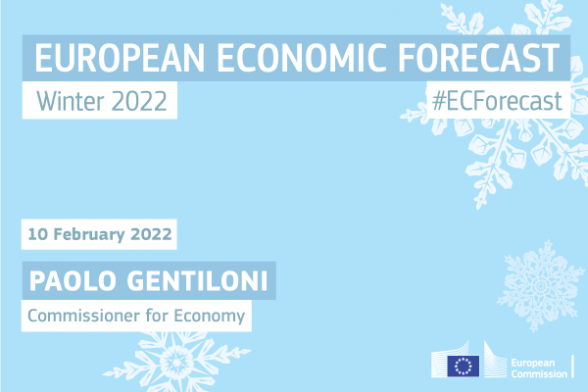The Winter 2022 Economic Forecast projects that, following a notable expansion by 5.3% in 2021, the EU economy will grow by 4.0% in 2022 and 2.8% in 2023. Growth in the euro area is also expected at 4.0% in 2022, moderating to 2.7% in 2023. The EU as a whole reached its pre-pandemic level of GDP in the third quarter of 2021 and all Member States are projected to have passed this milestone by the end of 2022.
Economic growth set to regain traction
After the robust rebound in economic activity that started in spring last year and continued unabated through early autumn, the growth momentum in the EU is estimated to have slowed to 0.4% in the last quarter of 2021, from 2.2% in the previous quarter. While a slowdown was already expected in the Autumn 2021 Economic Forecast, after the EU economy closed the gap with its pre-pandemic output level in 2021-Q3, it was sharper than projected as headwinds to growth intensified: notably, the surge in COVID-19 infections, high energy prices and continued supply-side disruptions.
Growth continues to be shaped by the pandemic, with many EU countries under pressure from a combination of increased strain on healthcare systems and staff shortages due to illness, precautionary quarantines or care duties. Logistic and supply bottlenecks, including shortages of semiconductors and some metal commodities, are also set to keep weighing on production, at least throughout the first half of the year. Last but not least, energy prices are now expected to remain elevated for longer than expected in the Autumn Forecast, thereby exerting a more protracted drag on the economy and higher inflationary pressures.
This forecast assumes that the strain on the economy caused by the current wave of infections will be short lived. Economic activity is set to regain traction, also as supply conditions normalise and inflationary pressures moderate. Looking beyond the short-term turbulence, the fundamentals underpinning this expansionary phase continue to be strong. A continuously improving labour market, high household savings, still favourable financing conditions, and the full deployment of the Recovery and Resilience Facility (RRF) are all set to sustain a prolonged and robust expansionary phase.
Upward revision to the inflation outlook
The forecast for inflation has been considerably revised upwards compared to the Autumn Forecast. This reflects the effects of high energy prices, but also the broadening of inflationary pressures on other categories of goods since autumn.
After reaching a record rate of 4.6% in the fourth quarter of last year, inflation in the euro area is projected to peak at 4.8% in the first quarter of 2022 and remain above 3% until the third quarter of the year. As the pressures from supply constraints and high energy prices fade, inflation is expected to decline to 2.1% in the final quarter of the year, before moving below the European Central Bank’s 2% target throughout 2023.
Overall, inflation in the euro area is forecast to increase from 2.6% in 2021 (2.9% in the EU) to 3.5% (3.9% EU) in 2022, before declining to 1.7% (1.9% EU) in 2023.
Uncertainty and risks remain high
Even though the impact of the pandemic on economic activity has weakened over time, ongoing containment measures and protracted staff shortages could drag on economic activity. They could also dent the functioning of critical supply chains for longer than expected. By contrast, weaker demand growth in the near-term may help to resolve supply bottlenecks somewhat earlier than assumed.
On the upside, household demand could grow more strongly than expected, as already experienced with the reopening of economies in 2020, and investments fostered by the RRF could generate a stronger impulse to activity.
Inflation may turn out higher than expected if cost pressures are eventually passed on from producer to consumer prices to a larger extent than projected, amplifying the risk of second-round effects.
Risks to the growth and inflation outlook are markedly aggravated by geopolitical tensions in Eastern Europe.
Members of the College said:
Valdis Dombrovskis, Executive Vice-President for an Economy that Works for People said: “The EU economy has now regained all the ground it lost during the height of the crisis, thanks to successful vaccination campaigns and coordinated economic policy support. Unemployment has reached a record low. These are major achievements. As the pandemic is still ongoing, our immediate challenge is to keep the recovery well on track. The significant rise in inflation and energy prices, along with supply chain and labour market bottlenecks, are holding back growth. Looking ahead, however, we expect to switch back into high gear later this year as some of these bottlenecks ease. The EU’s fundamentals remain strong and will be boosted further as countries start to put their Recovery and Resilience Plans into full effect.”
Paolo Gentiloni, Commissioner for Economy said: “Multiple headwinds have chilled Europe’s economy this winter: the swift spread of Omicron, a further rise in inflation driven by soaring energy prices and persistent supply-chain disruptions. With these headwinds expected to fade progressively, we project growth to pick up speed again already this spring. Price pressures are likely to remain strong until the summer, after which inflation is projected to decline as growth in energy prices moderates and supply bottlenecks ease. However, uncertainty and risks remain high.”
Background
The Winter 2022 Economic Forecast provides an update of the Autumn 2021 Economic Forecast, which was presented in November 2021, focusing on GDP and inflation developments in all EU Member States.
This forecast is based on a set of technical assumptions concerning exchange rates, interest rates and commodity prices with a cut-off date of 27 January. For all other incoming data, including assumptions about government policies, this forecast takes into consideration information up until and including 1 February.
The European Commission publishes two comprehensive forecasts (spring and autumn) and two interim forecasts (winter and summer) each year. The interim forecasts cover annual and quarterly GDP and inflation for the current and following year for all Member States, as well as EU and euro area aggregates.
The European Commission’s next forecast will be the Spring 2022 Economic Forecast, scheduled to be published in May 2022.
Source: Hellenic Shipping News






